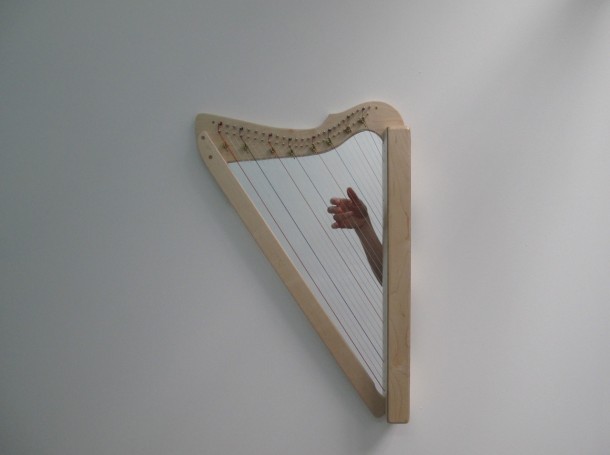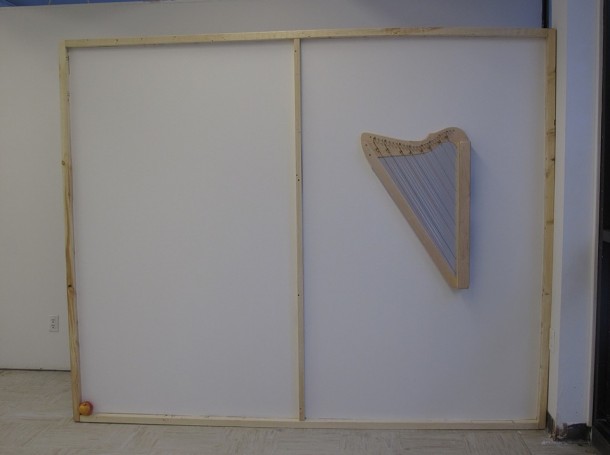Work
Comunitas (Wall / Harp)
Caption
2012
Particle board, timber, paint and classical harp
Dimensions variable
Courtesy of the artist
Artist
By
Text
—
When you approach the intruding precarious wall of Comunitas (Wall/Harp) you become aware of its temporariness, built and designed with functionally as its DNA . This prosthetic structure contains within its liminal space, a small harp is snugly secured in a cut out, acting as a transitory border between either sides of the wall. The architecture of the arrangement prohibits willing players to cradle the harp into their body, denying them the ability to place both hands on either side of the strings. Here Guillerme E. Rodriguez Rivera stages a rather cruel trick on the visitor. The dumbness of this pre-empted relationship, existing between the anticipation of the visitor and the potential of the situation, only appears after the sensuality of the presence of the instrument has taken its effect on its subject—like a siren calling sailors to a rocky cove.
This is a radical form of hospitality staged by Rodrigeuz, who invites you to consider an unusual way of belonging together. The work suggests that two people play a duet from either side of the wall. Without the ability to see each other, the only sensory call and response between the players comes from the sound of the instrument. Will frustration and defeat ensue if we are to choose this optimistic but naive position when approaching the equation of community and collaboration? Despite this, inherent in the work is the cynic’s core position; optimism for the small probability of good to emerge in the world. Rodriguez proposes this provocative scenario by ultimately seeing some prospect for certain players to find harmony within this obtuse triangulation.
—
Ludic, a term used by Rodriguez to describe his work, comes from the writer and philosopher Nassim Nicholas Taleb, which is used to define games and play as scenarios in order to consider chance as one of the central guiding forces of our universe. Chance is central to most of our own lives and their winding turns. The unforeseen affects us by asking us to alter course and to adapt in relation to it. Or, in a negative sense of the position, to censor what we do, so that we behave in a way to know our outcomes, marking us as fearful of the irregular. Rodriguez harnesses these intuitive impulses as a guiding force, hacking the already made and redefining their intended uses to produce varying results of success and failure from a user generated perspective.
Reminiscent of modern art’s leaders, such as Giaciometti’s board game On Ne Joue Plus (1932), Duchamp’s chess match versus Cage (1968) or Hacke’s MOMA Poll (1970), the potentiality of chance is exploited as the work’s central force, taking both a submissive but also freeing position towards risk. Also introducing the act of joy, liveliness and performance into the gallery space, Rodriguez references a geographically closer canon of artists such as Oiticia’s Eden (1969), Clark’s Sensory Masks (1971) or Pape’s Ttéia Cuadrada (1976), who also invited the participation of the visitor in the work, allowing for a reactivation of the gallery’s neutral space.

